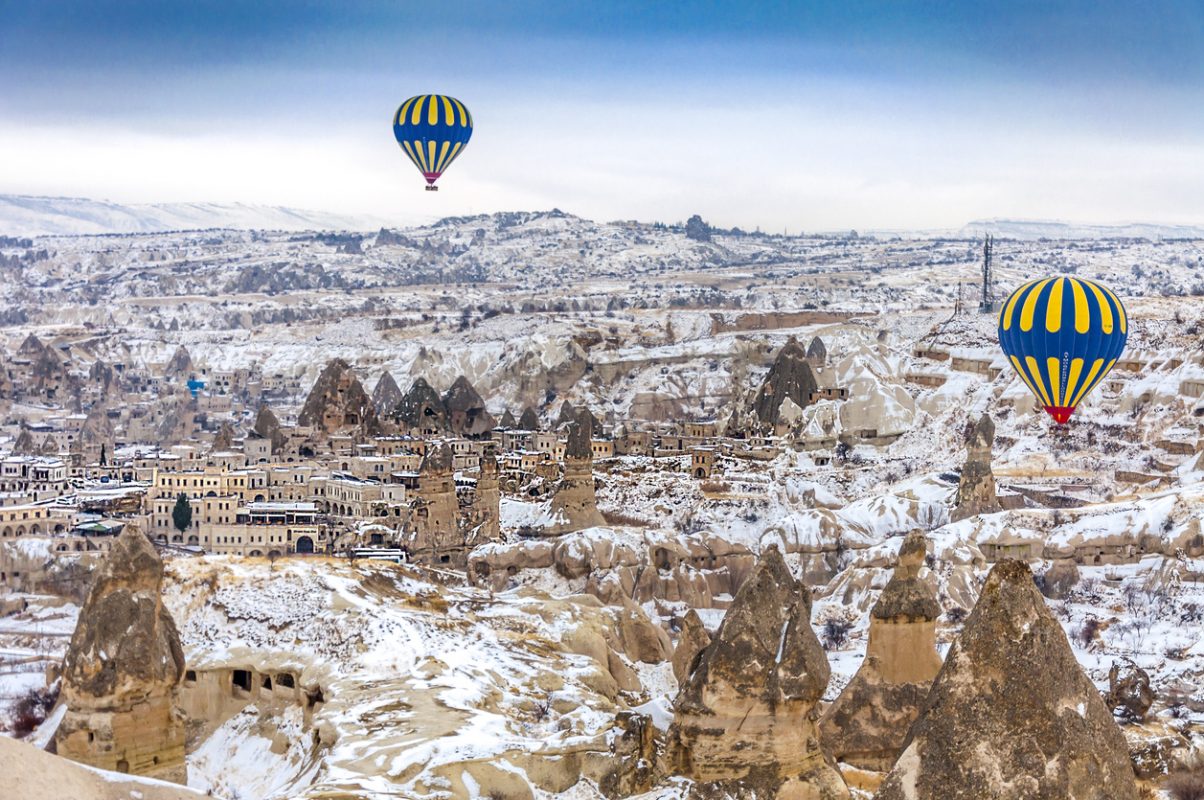Does it snow in Turkey?
I’ve been to Turkey five times in the winter months, and have experienced different weather every single time.
Antalya basked in glorious sunny conditions, Istanbul had a mix of blustery and sunny spells, and Ankara was bone-chillingly cold.
And Cappadocia? Cappadocia was covered in brilliant white snow.
If you’re wondering does it snow in Turkey: yes, yes it does.
BUT, it very much depends on where you are. Turkey’s a huge, geographically diverse country; so whether you want to experience or avoid snow, it’s a good idea to fully research it before heading here!
If you’re wondering about snowy weather in Turkey, you’re in luck; I’ve put together a this article about when and where to expect snow!
Does it snow in Turkey?
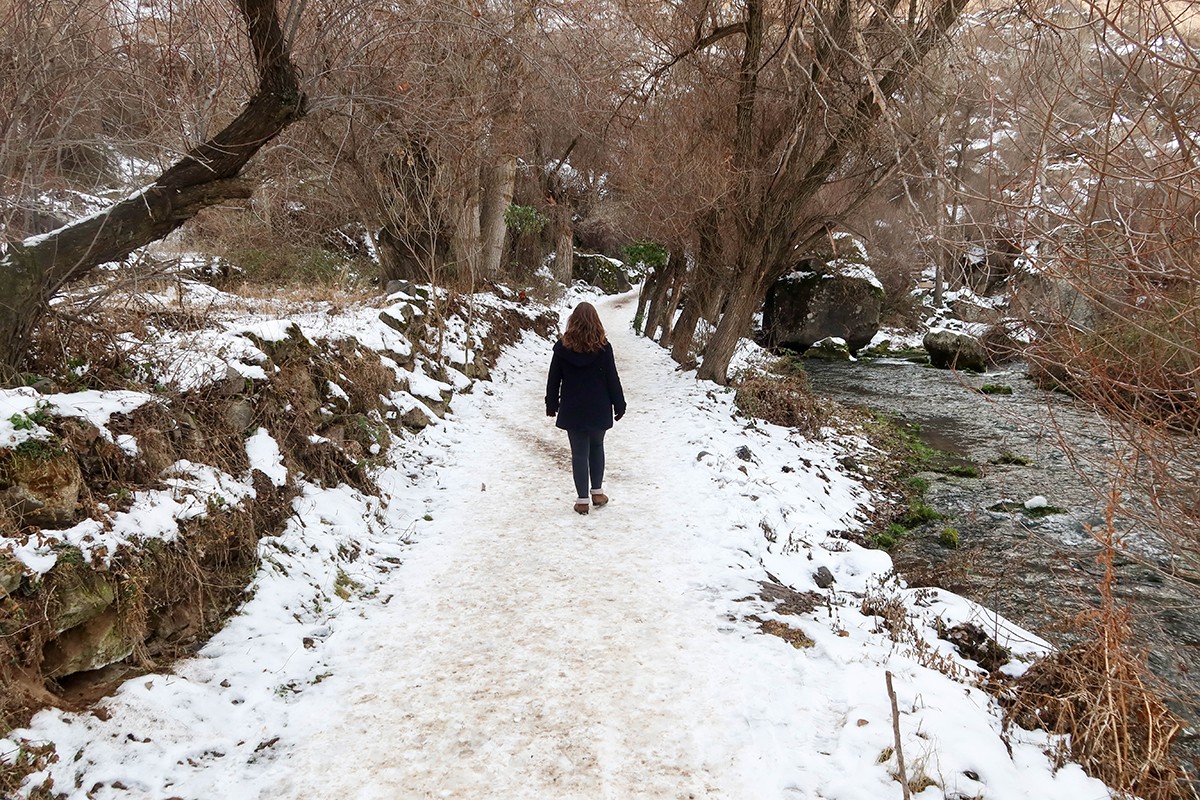
Absolutely, it does snow in Turkey!
However, the intensity and frequency of snowfall vary dramatically across the country due to its geographical diversity.
While some areas experience heavy snowfall during the winter months, others see only a dusting – and some regions see no snow at all.
This variability makes Turkey a fascinating destination for those seeking both winter wonderlands and milder winter climates.
Let’s delve into the details to understand when and where snowfall occurs in Turkey.
When does It snow in Turkey?
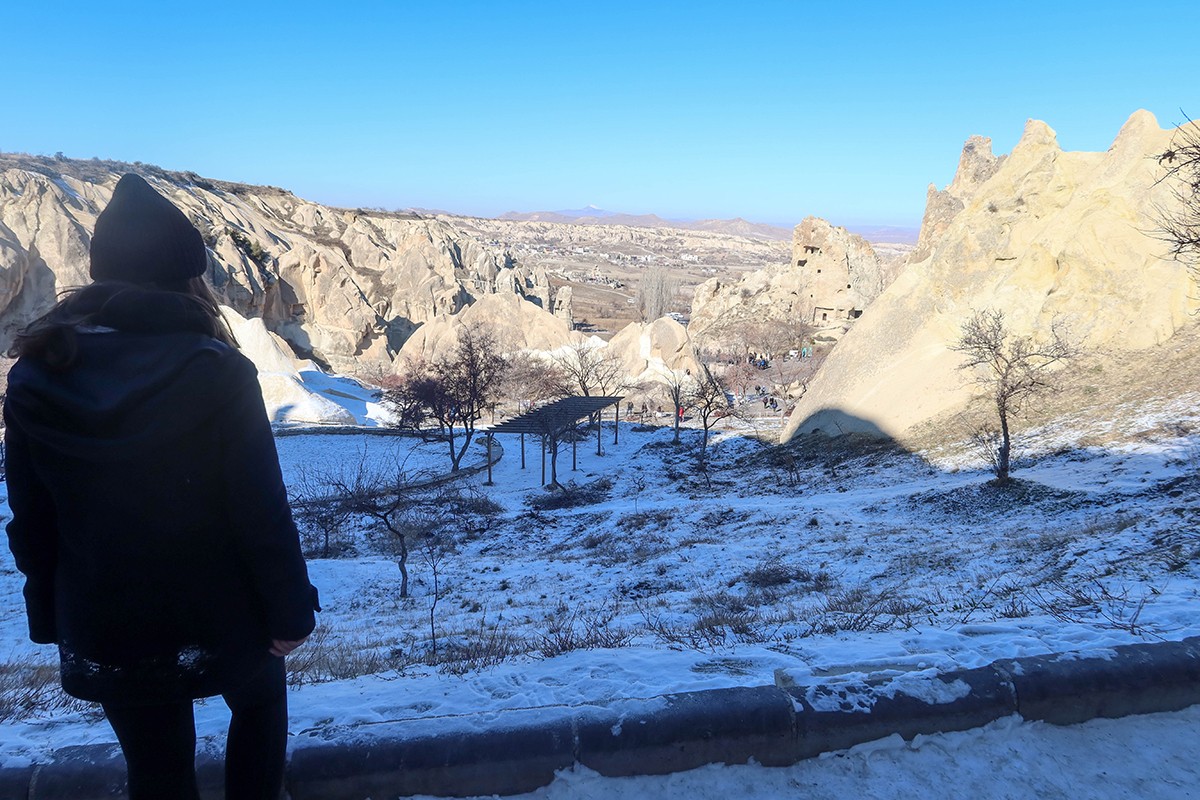
The snowfall timeline in Turkey is quite varied due to the country’s diverse climate and geography.
While snowflakes start to appear in some regions as early as November, others remain snow-free until later in the winter.
With the country spanning both temperate and Mediterranean climates, the timing, intensity, and duration of snowfall can be a surprising mix.
Here’s a month-by-month breakdown:
Does it snow in Turkey in November?
November marks the beginning of winter in Turkey and with it comes the first snowfall of the season, particularly in the eastern highlands.
Cities like Erzurum and Kars, sitting over 1,500 meters above sea level, start to see a dusting of snow.
The western regions and the Mediterranean coast, however, still enjoy mild weather with just an occasional chill in the air!
Does it snow in Turkey in December?
As December rolls in, the frequency and intensity of snowfall increase, especially in the eastern and central parts of the country.
Ankara, in the heart of Turkey, can see moderate snow during this month.
In Istanbul, snow is a less common occurrence, but the city does occasionally see it!
Does it snow in Turkey in January?
January is the heart of the winter season in Turkey and subsequently, it’s the snowiest month!
In the mountainous eastern regions, snow can pile up to quite significant heights!
Even the usually milder western coast experiences cold snaps, with cities like Izmir occasionally getting a dusting of snow.
Does it snow in Turkey in February?
In February, snow continues to fall heavily in the eastern and central regions.
By the end of the month, the coastal areas start to see a decrease in snowfall, although chilly weather still prevails.
Istanbul in February often warms up, and you can often expect to see sunnier, milder weather here!
Does it snow in Turkey in March?
By March, the snow starts to recede, especially in the western and southern parts of the country.
However, the eastern highlands remain in the grip of winter, often seeing snowstorms and frigid temperatures.
Does it snow in Turkey in April?
Snowfall in April is typically limited to the highest peaks of the eastern mountains.
The rest of the country begins to welcome the spring, with blooming flowers replacing the snow-covered landscapes.
Where does it snow in Turkey?
Snowfall in Turkey varies considerably across its diverse landscapes.
Let’s dig into each of the different areas and whether you can expect snow in each of them:
Marmara Region
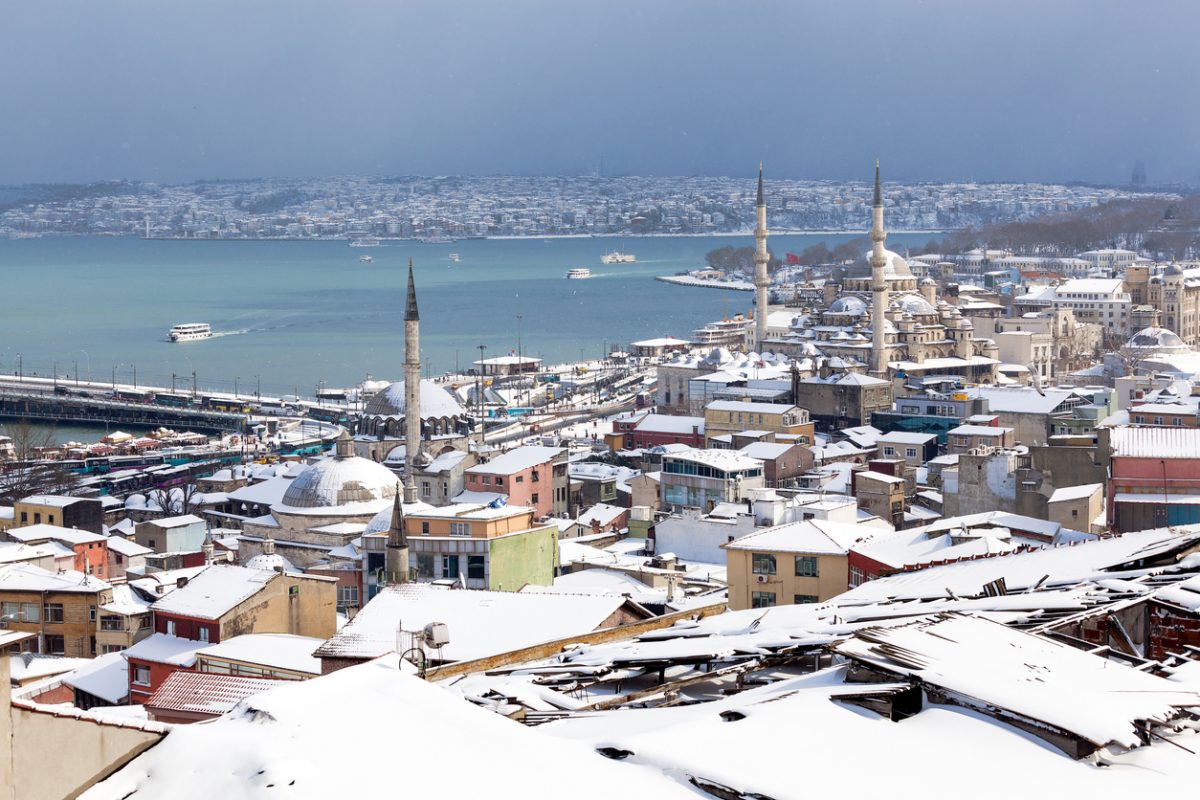
The Marmara Region, home to Istanbul and its surrounding areas, does not frequently experience heavy snowfall.
Istanbul does occasionally see snow, which lends a wintery charm to its historic architecture and streets.
Even light snowfall can cause traffic disruptions and slight delays in public services – a little like how we can’t cope with the snow in England!
These instances of snow are quite sporadic and do not characterize a typical Istanbul winter, which is more often cold and wet rather than snowy.
Black Sea Region
Snowfall is common in the Black Sea Region during the winter months.
Thanks to its hilly terrain and high elevations, areas like Rize and Artvin often see substantial snowfall.
Aegean Region
The Aegean Region, known for its warm climate and beautiful coastlines, generally does not experience heavy snowfall.
Cities like Izmir and Bodrum are known more for their sunny days than their snowy ones.
It does happen every so often, though!
Mediterranean Region
As with the Aegean Region, the Mediterranean Region, including popular tourist destinations like Antalya, typically experiences mild, wet winters with little to no snowfall.
Snow is very rare along the coast – it’s a little like the climate of Malta – but can occasionally fall in the mountainous interiors.
Central Anatolia Region
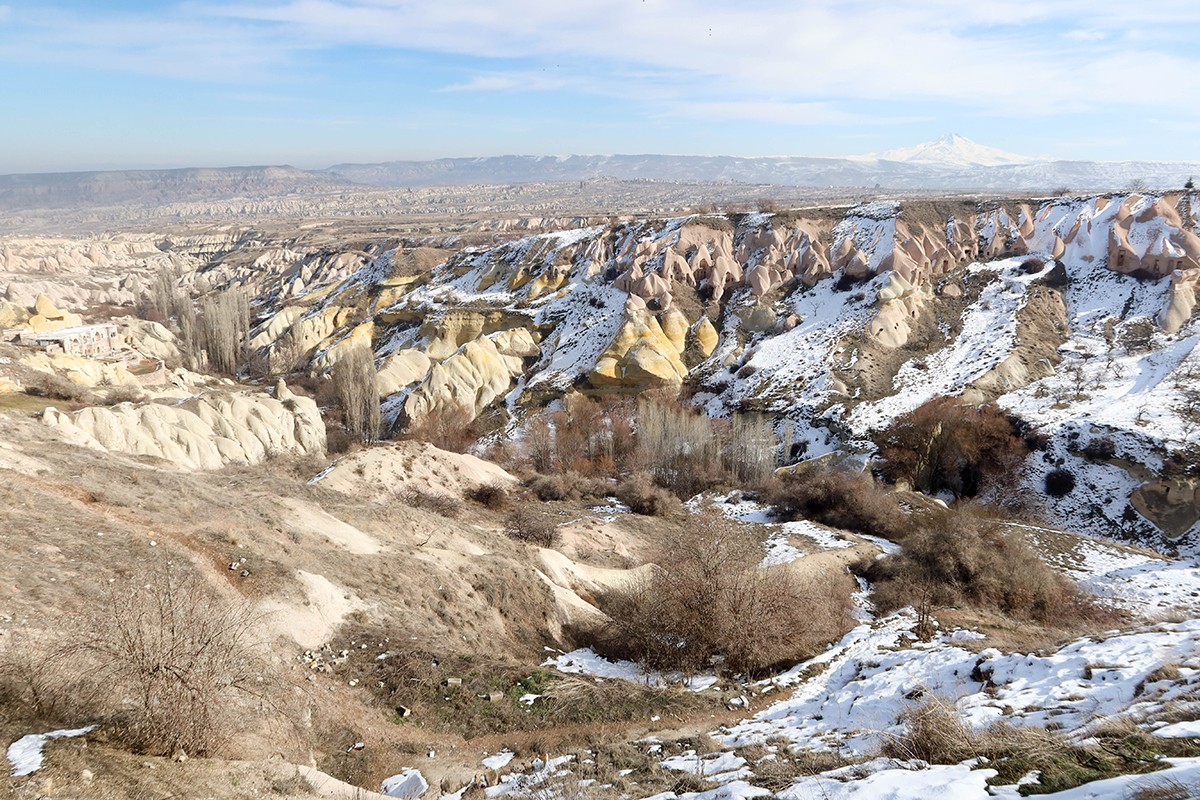
The Central Anatolia Region, including the country’s capital Ankara and the famous region of Cappadocia, experiences much colder winters than other parts of Turkey with moderate to heavy snowfall.
Ankara, due to its high altitude and landlocked position, can see significant snow during winter, while Cappadocia’s unique rock formations often get a magical blanket of snow.
Eastern Anatolia Region
The Eastern Anatolia Region experiences some of the harshest winters in Turkey, with heavy snowfall being quite common.
Known for its rugged mountain ranges, this region sees substantial snow that can often last from late autumn to early spring.
Southeastern Anatolia Region
The Southeastern Anatolia Region, in contrast, sees very little snow.
Its winter climate is generally milder, similar to that of the Mediterranean Region.
While occasional snowfall can occur, particularly in higher areas, it’s not a defining feature of winter in this region.
Does it snow in Istanbul?
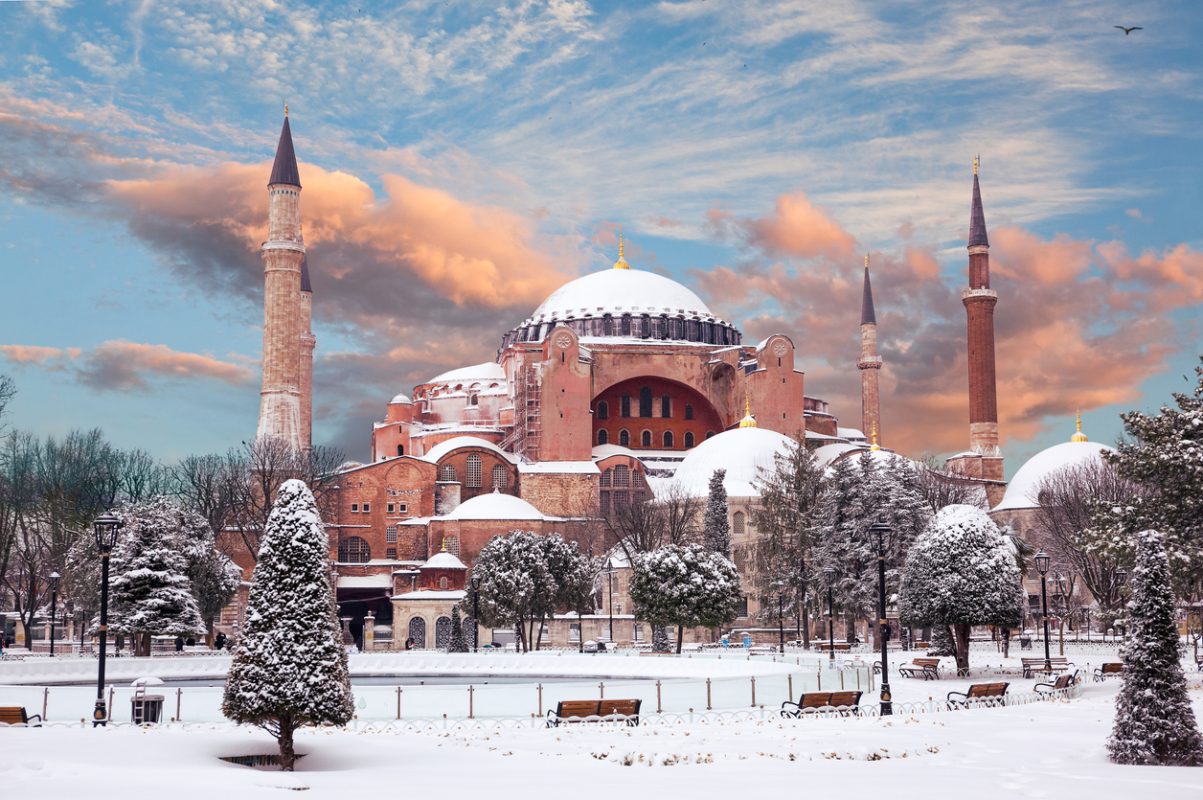
While it’s not frequent, the city streets of Istanbul are occasionally covered with a light dusting of snow – but entire years do go by with none of the white stuff.
Check out my full article about snow in Istanbul by clicking here.
Does it snow in Cappadocia?

Cappadocia, renowned for its unique rock formations and hot air balloon rides, is a popular place in Turkey where you can experience snow.
The region has a continental climate with cold, snowy winters.
When snow adorns the fairy chimneys and valleys of Cappadocia, the landscape transforms into an ethereal scene straight out of a fantasy tale!
Check out my guide to snow in Cappadocia by clicking here.
Does it snow in Ankara?

Ankara, the capital city located in the heart of Turkey, experiences a semi-arid climate with cold and relatively snowy winters.
The snowfall here is more consistent compared to coastal regions like Istanbul.
That being said, it quite often doesn’t snow too. When we visited Cappadocia and Ankara one winter, Cappadocia was blanketed in snow whereas Ankara didn’t have any.
Does it snow in Antalya?
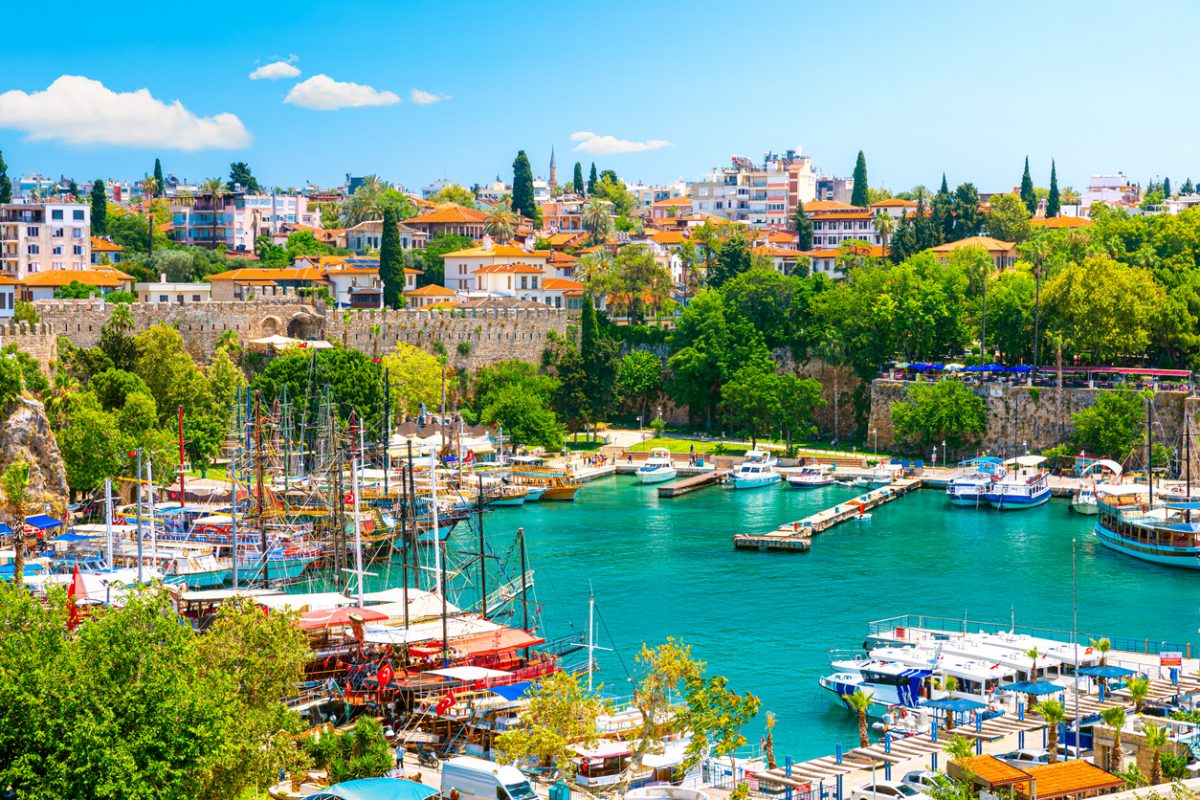
Known for its warm Mediterranean climate, Antalya doesn’t see snowfall.
The region’s winters are mild, and snow is rare.
Within a short drive from the city, you can reach the snow-clad Taurus Mountains, a stark contrast to Antalya’s sunny beaches.
Other snowy places in Turkey

Below are some other particularly snowy places in Turkey!
- Erzurum: Found in Eastern Anatolia, Erzurum is known as one of the coldest cities in Turkey, experiencing heavy snowfall during the winter months.
- Kars: Another city in Eastern Anatolia, Kars receives plenty of snow during winter. The snowy landscapes provide breathtaking views, especially the medieval ruins of Ani, known as the “City of 1001 Churches,” which take on an ethereal quality when dusted with snow. Kars is also the start of the Eastern Express train which links to Ankara and traverses through a glorious snow-covered landscape.
- Bolu: Located in the Western Black Sea region, Bolu is known for its beautiful natural landscapes and is a popular destination for winter sports, thanks to its significant snowfall. The Kartalkaya ski resort in Bolu is one of Turkey’s top skiing destinations.
- Uludağ: Uludağ mountain in Bursa province, in the Marmara region, is the country’s most popular ski resort area. The mountain sees heavy snowfall in the winter, providing excellent conditions for winter sports.
Why does it snow in Turkey?
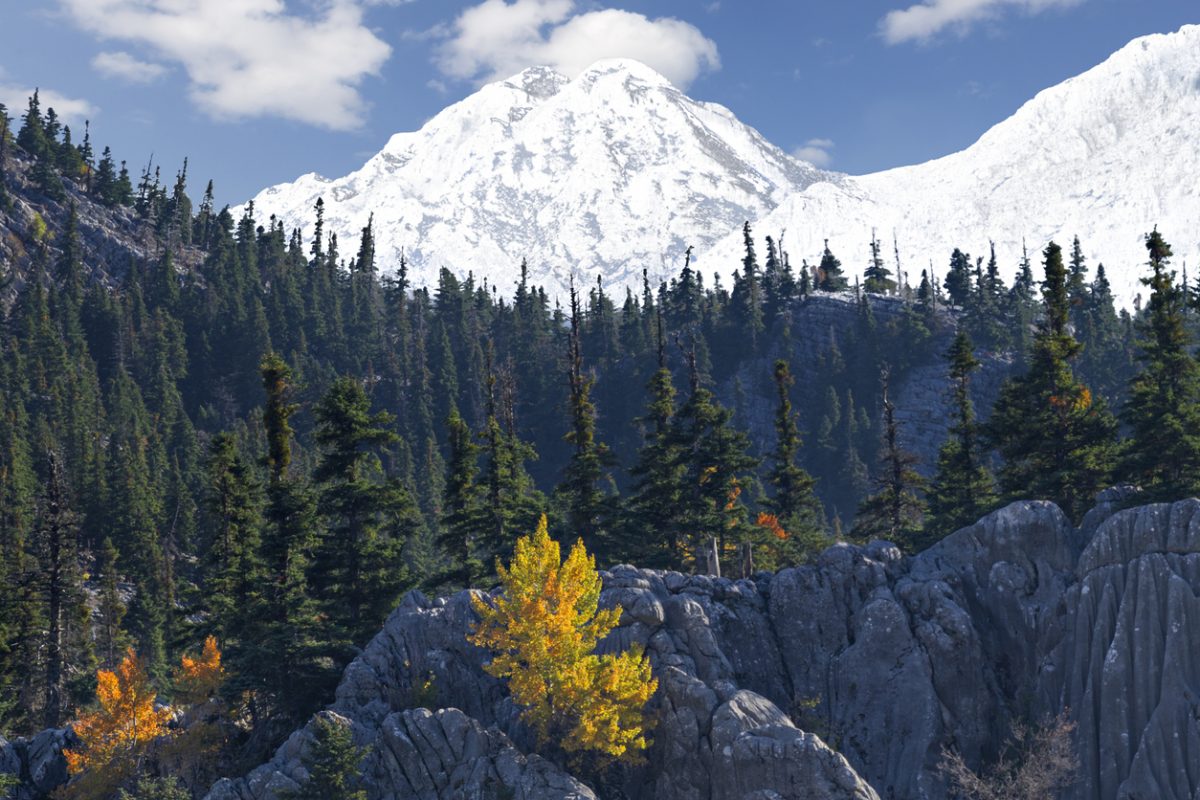
Turkey is a fascinating country in terms of its climate due to its unique geographical location.
It’s positioned at the crossroads of Europe and Asia, with a large part of the country being surrounded by three different seas, each with its own climatic influences.
The country’s diverse topography, which includes high mountain ranges, plateaus, and valleys, plays a significant role in its weather patterns.
In regions like Eastern Anatolia and Central Anatolia, which are characterized by high altitudes and a landlocked position, the climate is continental.
Here, the winters are cold and snowy due to the influence of cold air masses from the north, as well as the high elevation.
On the other hand, coastal regions such as the Aegean and Mediterranean are influenced by their proximity to the sea.
These areas have a Mediterranean climate with mild, wet winters and hot, dry summers. While snowfall can occur, it’s much rarer due to the relatively warmer and moister air from the sea.
The Marmara region, where Istanbul is located, sits between the Black Sea and the Aegean Sea.
The climate here is a blend of Mediterranean and continental climates, leading to occasional snowfall in winter.
The Black Sea Region has a different climate altogether due to its northern location and the influence of the Black Sea.
This region experiences a high amount of rainfall year-round, leading to snowy winters, especially in the hilly and mountainous areas.
That being said, the closer you are to the actual Black Sea Coast, the lower the chance of snow.
What’s Turkey like when it snows?
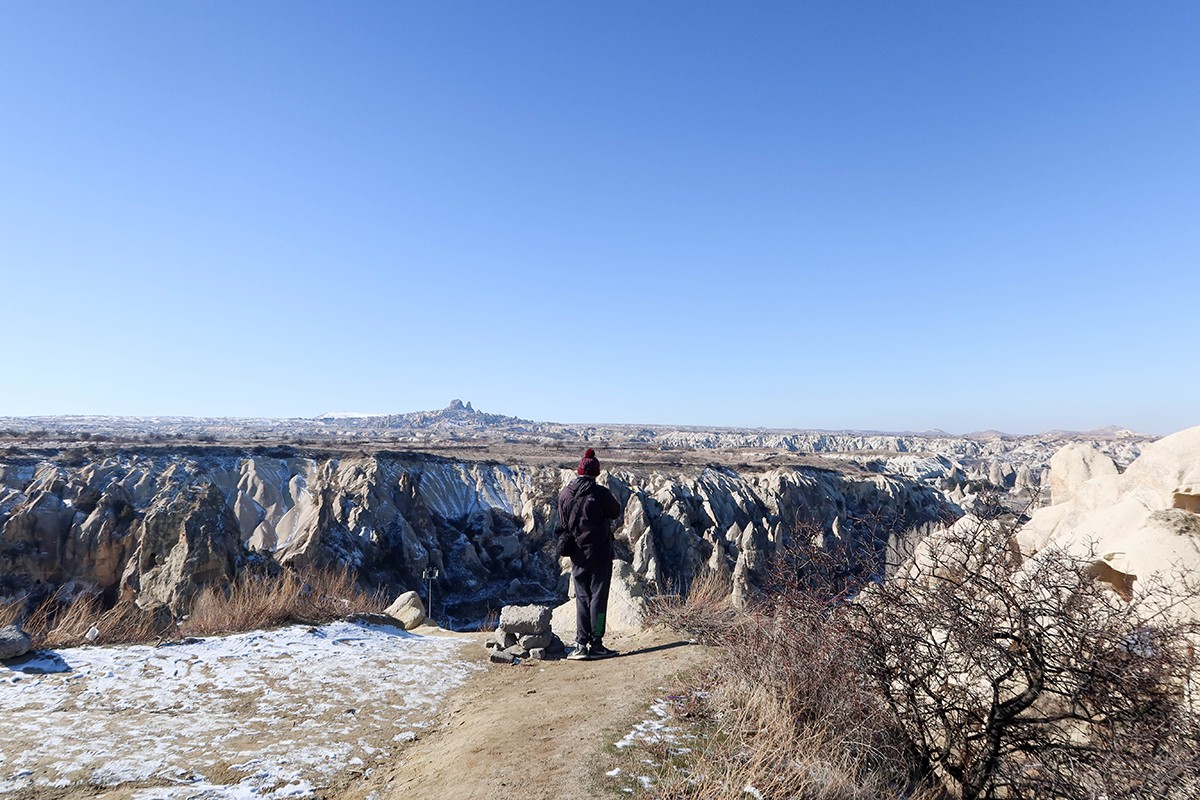
As snow patterns are so varied in Turkey, people are different degrees of prepared for it!
In regions like Eastern Anatolia and Central Anatolia, where snowfall is a common occurrence during the winter, people are generally well-prepared.
They have adapted to the snowy winters with appropriate clothing, winterized vehicles, and heated homes.
The occasional snowfall in Istanbul causes some disruptions, as the city’s not adapted to snow (it’s a bit like the snow in England!).
Destinations like Uludağ in Bursa and Palandöken in Erzurum are well-known ski resorts that attract winter sports enthusiasts.
Snow also enhances the magical atmosphere of regions like Cappadocia – I think that it’s the best time to visit.
Travelling in Turkey in the snow

Here are some practical tips for visiting Turkey in the snow:
- Prepare for the weather: Turkish winter can be very cold in snow-prone regions like Eastern and Central Anatolia. Pack plenty of warm clothing, including a good quality winter jacket, hats, scarves, gloves, and thermal wear. Waterproof shoes or boots are also essential for walking in the snow.
- Check the forecast: Always keep an eye on the weather forecast before setting out for the day. Weather can change rapidly, and heavy snowfall can disrupt travel plans.
- Drive safely: If you plan to rent a car, ensure that it is well equipped for winter driving with snow chains and winter tyres if necessary. Always follow local traffic advisories and consider hiring a local guide or driver experienced in navigating snowy conditions.
- Winter Activities: Make the most of the snow by participating in winter activities. Skiing, snowboarding, and sledging are popular in ski resorts like Uludağ and Palandöken. And a hot air balloon ride over a snow-covered Cappadocia can’t be missed!
- Cultural Sightseeing: Turkey’s historic and cultural landmarks take on a unique beauty in the snow. Istanbul’s Hagia Sophia and Blue Mosque, or Cappadocia’s fairy chimneys, are particularly mesmerizing under a blanket of snow. Ensure to check opening hours as they may vary in winter.
- Local Cuisine: Warm up with some local Turkish cuisine. Enjoy a hearty lentil soup (Mercimek çorbası) or a hot cup of Turkish tea (çay) or coffee in a local café.
- Health and Safety: Keep a basic first aid kit handy. Cold weather can sometimes lead to health issues like colds, flu or frostbite. Stay hydrated and protect your skin from the harsh cold using moisturisers.
Frequently Asked Questions
Here are some answers to frequently asked questions about Turkey in the snow!
Which part of Turkey has snow?
Snowfall in Turkey is most common in the Eastern Anatolia region, which is also the coldest part of the country. Central Anatolia, including Ankara, also sees considerable snow in winter. Istanbul and other parts of the Marmara region can experience snow, but it is typically less frequent and intense.
Which part of Turkey has snow in November?
In November, the higher altitude regions of Eastern Anatolia and Central Anatolia are likely to experience the first snowfall of the season. However, snow in November is generally less predictable and depends on the specific weather patterns of the year.
When can I see snow in Turkey?
Snow in Turkey is most likely from December to March, with January and February being the peak snowfall months. However, the timing and intensity of snow can vary depending on the region.
What is the snowiest city in Turkey?
Erzurum, located in Eastern Anatolia, is one of the snowiest cities in Turkey due to its high altitude and cold winter climate. It’s also home to the Palandöken Mountain, one of Turkey’s most popular ski resorts.
Where is Turkey snowiest?
The snowiest regions in Turkey are the Eastern Anatolia and Central Anatolia regions due to their higher altitudes and colder winter temperatures. These regions are home to several mountain ranges where heavy snowfall is common.
Can we see snow in Turkey in December?
Yes, it’s possible to see snow in Turkey in December, especially in the high altitude regions of Eastern Anatolia and Central Anatolia. Snow in other parts of the country, like Istanbul, is less predictable but can occasionally occur in December.
Are you ready for Turkey in the snow?
If you’re planning a winter holiday in Turkey, the chance of seeing snow largely depends on where you are.
Visiting Cappadocia in January? You’ll have freezing winter weather, and subsequently snow.
Heading on a winter trip to Antalya? This part of Turkey has much more mild winters, and snow is very unlikely.
Visiting Istanbul in February? While it’s a fantastic destination this month, winter snowfall is very rare – but it could happen.
Hopefully, this article has helped you decide where to go – or avoid – if you’re looking for snow in Turkey!

